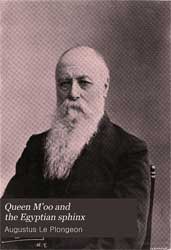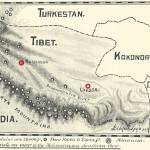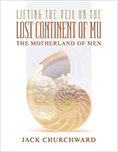In James Churchward’s books, the Naacal Tablets play an important role as the proof of an ancient advanced civilization named Mu.
For a bit of background, in 1926, James wrote in Lost Continent of Mu Motherland of Men that while on famine relief duty in India, he befriended a Rishi of the local temple and spent some years learning the meanings of symbols and glyphs from the Rishi. After a period of time, the Rishi showed James some clay tablets and together they examined and translated them. The Rishi revealed that only he and two others knew the hidden meanings in the tablets and that they were the last of the Naacal Brotherhood, the keepers of the knowledge and wisdom of the now-sunken continent of Mu in the Pacific Ocean. The tablets revealed that the Garden of Eden was not in the Middle East, but on Mu, that Mu was an advanced civilization many tens of thousands of years old, and that science and religion were fused together in their belief system.
Cover of Queen M’oo and the Egyptian Sphinx
In the 1896 “Queen Moo and the Egyptian Sphinx” by Augustus LePlongeon, it is stated [pages xxiii – xxiv of the preface] that Mayan adepts, known as the Naacal (Naacal = ‘the Exalted’) traveled across the globe colonizing the planet and bringing ancient wisdom and knowledge as Mayan missionaries. LePlongeon postulated that the actual birthplace of mankind was in Central America and his archaeological excavations had shown him the proofs he needed.
From James’ biography written in 1936, Percy Tate Griffith, notes that in 1890s, regular Sunday afternoon visitors to the Griffith house included Churchward and LePlongeon and others for discussions on metaphysical topics of the day. James also notes in his books that LePongeon allowed him the opportunity to copy his notes and books, so there is a known connection between the two men.
There are some differences between their theories:
- For LePlongeon, the Maya were the people of the advanced ancient civilization of Central America; Churchward wrote that the Maya were the people that colonized the world from the now sunken continent of Mu (as opposed to the people that stayed home.)
- For LePlongeon, mankind’s birthplace or “Garden of Eden” was in Central America”; Churchward wrote that it was in the Pacific Ocean on the now-sunken continent of Mu.
- According to LePlongeon, his ‘land of Mu’ was in the Atlantic, and that the inhabitants of this island continent were so enamored with Queen Moo that they named their island after her before she traveled to Egypt and imparted wisdom and knowledge on them. To LePlongeon, the island was also known as Atlantis. For Churchward, Mu was in the Pacific Ocean.
- For LePlongeon, the source for his information on Mu was the mistranslation of the Troano Manuscript, which is actually a Mayan astronomical treatise and only a part of the Madrid Codex. For Churchward, the Naacal Tablets were the source of his information on Mu.
Despite recent claims to the contrary, James is the only person to have seen the Naacal Tablets, except for visitors to the Khanassa monastery.
James did write that there is a monastery in Khanassa, Tibet (“very well known and often visited by Europeans and Russians”) where a complete set of the tablets exists, but that was from the 1927 Books of the Golden Age, and was not supposed to be published according to text inside the book. In all other instances, James did not reveal the location so as to protect the tablets.
Are there other mentions of Tablets discussing the land of Mu prior to the 1926 Lost Continent of Mu Motherland of Men?
In the next installment, we’ll dig into James’ scrapbooks for the answer.
Have a great day









 RSS - Posts
RSS - Posts